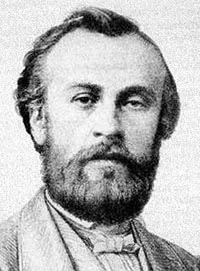Henri Giffard
This article needs additional citations for verification. (July 2007) |



Henri Giffard (8 February 1825 – 14 April 1882) was a French engineer. In 1852, he invented the steam injector and the powered airship.
Career
The steam powered airship was made by Baptiste Jules Henri Jacques Giffard who was born in Paris in 1825. He invented the injector and the Giffard dirigible, an airship powered with a steam engine, and weighing over 180 kg (400 lb), it was the world's first passenger-carrying airship (then known as a dirigible, which was French ).[1] Both practical and steerable, the hydrogen-filled airship was equipped with a 3 hp steam engine that drove a propeller. The engine was fitted with a downward-pointing funnel. The exhaust steam was mixed in with the combustion gases and it was hoped by these means to stop sparks rising up to the gas bag; he also installed a vertical rudder.
On 24 September 1852 Giffard made the first powered and controlled flight travelling 27 km from Paris to Élancourt.[2] The wind was too strong to allow him to make way against it, so he was unable to return to the start.[2] However, he was able to make turns and circles,[citation needed] proving that a powered airship could be steered and controlled.
Giffard was granted a patent for the injector on 8 May 1858. Unusually, he had thoroughly worked out the theory of this invention before making any experimental instrument, having explained the idea in 1850. Others had worked on using jets, particularly Bourdon who patented a very similar device in 1857.[3]
In 1863 he was appointed a Chevalier of the Légion d'honneur.[4]
Death and commemoration
In response to his declining eyesight, Giffard committed suicide in 1882,[4] leaving his estate to the nation for humanitarian and scientific purposes.
Gallery
-
Balloon of Henri Giffard over Paris rooftops, 1878.
-
A model of the Giffard Airship at the London Science Museum.
-
Medal of Giffard's balloon over Paris in 1878.
See also
References
- ^ Cite error: The named reference
Giffard_1was invoked but never defined (see the help page). - ^ a b Science Museum - Home - The Giffard Airship, 1852., Science Museum, retrieved 2009-05-09
- ^ Kneass, Strickland L. (2004) [1894], Practice and Theory of the Injector, New York: Wiley, ISBN 1-55918-306-3
- ^ a b Day, Lance; McNeil, Ian (1996), "Giffard, Baptiste Henri Jacques (Henri)", Biographical Dictionary of the History of Technology, Taylor & Francis, pp. 285–286, ISBN 978-0-415-06042-4, retrieved June 24, 2009
External links
- Who Was the First Person to Fly? at the Wayback Machine (archived March 5, 2008) - discusses Henri Giffard's first powered flight, LiveScience.com, March 4, 2008



